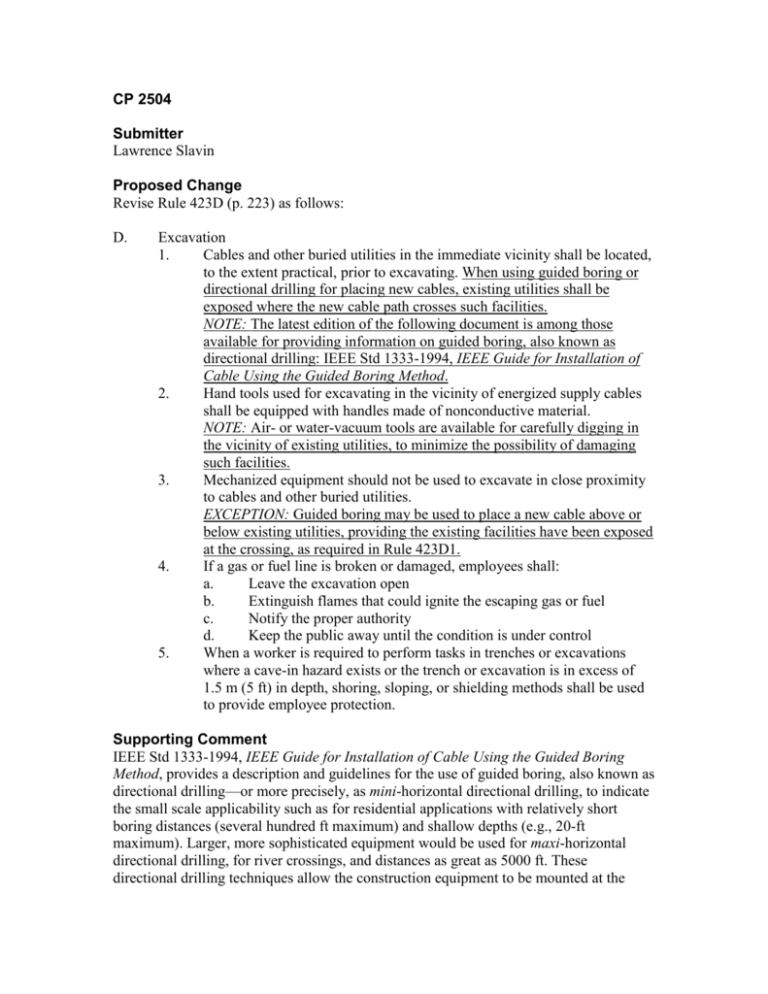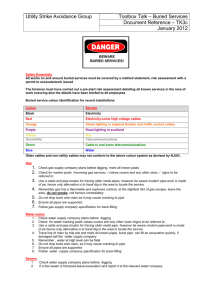CP 2504
advertisement

CP 2504 Submitter Lawrence Slavin Proposed Change Revise Rule 423D (p. 223) as follows: D. Excavation 1. Cables and other buried utilities in the immediate vicinity shall be located, to the extent practical, prior to excavating. When using guided boring or directional drilling for placing new cables, existing utilities shall be exposed where the new cable path crosses such facilities. NOTE: The latest edition of the following document is among those available for providing information on guided boring, also known as directional drilling: IEEE Std 1333-1994, IEEE Guide for Installation of Cable Using the Guided Boring Method. 2. Hand tools used for excavating in the vicinity of energized supply cables shall be equipped with handles made of nonconductive material. NOTE: Air- or water-vacuum tools are available for carefully digging in the vicinity of existing utilities, to minimize the possibility of damaging such facilities. 3. Mechanized equipment should not be used to excavate in close proximity to cables and other buried utilities. EXCEPTION: Guided boring may be used to place a new cable above or below existing utilities, providing the existing facilities have been exposed at the crossing, as required in Rule 423D1. 4. If a gas or fuel line is broken or damaged, employees shall: a. Leave the excavation open b. Extinguish flames that could ignite the escaping gas or fuel c. Notify the proper authority d. Keep the public away until the condition is under control 5. When a worker is required to perform tasks in trenches or excavations where a cave-in hazard exists or the trench or excavation is in excess of 1.5 m (5 ft) in depth, shoring, sloping, or shielding methods shall be used to provide employee protection. Supporting Comment IEEE Std 1333-1994, IEEE Guide for Installation of Cable Using the Guided Boring Method, provides a description and guidelines for the use of guided boring, also known as directional drilling—or more precisely, as mini-horizontal directional drilling, to indicate the small scale applicability such as for residential applications with relatively short boring distances (several hundred ft maximum) and shallow depths (e.g., 20-ft maximum). Larger, more sophisticated equipment would be used for maxi-horizontal directional drilling, for river crossings, and distances as great as 5000 ft. These directional drilling techniques allow the construction equipment to be mounted at the ground surface, avoiding the need for significant trenches at the ends of the bore path. Originally developed and introduced by the electric power industry (EPRI-sponsored) within the past 10–15 years, guided boring (mini-horizontal directional drilling) is now widely used by the power and telecommunications industries for distribution cable upgrades in established areas with buried facilities. The technique avoids the need for unsightly, inconvenient continuous trenching operations and the associated restoration expenses. The NESC should recognize the existence of this commonly used, important cable installation technique in order to maintain the relevance of the standard, as well as to provide appropriate rules for safety. One feature of the guided boring method is the ability to place new cable above or below existing facilities. Such operations, however, must be accompanied by stringent safety rules, including the identification, location, and possible exposure of existing utilities in the vicinity of the new construction activities. This need is emphasized by the inability to actually see the progress of the new cable path as the boring proceeds beneath the ground. In particular, utilities must be carefully exposed, using appropriate tools (e.g., hand tools, air- or water-vacuum systems, etc.) at all intended crossings of the new path with existing cables or utility lines. Thus, the progress of the boring and location of the drill head may be visually confirmed to be safely beneath or above the existing lines being crossed. Subcommittee 8 Recommendation Accept as modified. Subcommittee 8 Comment Revise Rule 423D (p. 223) as follows: D. Excavation 1. Cables and other buried utilities in the immediate vicinity shall be located, to the extent practical, prior to excavating. 2. When using guided boring or directional drilling for placing new cables, existing utilities should be exposed where the new cable path crosses such facilities. (Include a reference to IEEE Std 1333-1994 in Appendix B, Bibliography.) 3. 2. Hand tools used for excavating in the vicinity of energized supply cables shall be equipped with handles made of nonconductive material. 3. 4. Mechanized equipment should not be used to excavate in close proximity to cables and other buried utilities. 4. 5. If a gas or fuel line is broken or damaged, employees shall: a. Leave the excavation open b. Extinguish flames that could ignite the escaping gas or fuel c. Notify the proper authority d. Keep the public away until the condition is under control 5. 6. When a worker is required to perform tasks in trenches or excavations where a cave-in hazard exists or the trench or excavation is in excess of 1.5 m (5 ft) in depth, shoring, sloping, or shielding methods shall be used to provide employee protection. Vote on Subcommittee 8 Recommendation Affirmative: (18) Brooks, Brubaker, Doering, Erga, Fass, Grose, Henry, Hunt, Kientz, Mitchell, Poholski, Schweitzer, Spadafore, Theis, Tomaseski, Tootle, Tuggle, White Negative: (1) McKinney Abstention: (0) Explanation of Vote McKinney: Given 2-ft location variance, parallel cabling in a small right-of-way (row) could result in a large amount of exposure. Also, the rule may promote excessive exposure of electric services owned by the utility or customer when telecommunication lines are installed.







